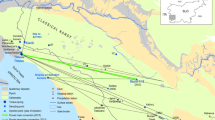Abstract
The role of the unsaturated zone in the karst aquifer hydraulic behaviour was brought into focus in these studies of the catchment of the Hubelj spring (SW Slovenia). The variations of natural tracers in precipitation and in groundwater during a summer storm event made it possible to trace local flow and solute transport in the observed aquifer. The results produced data on the aquifer recharge, storage and discharge processes, as well as on mechanisms that affected them, which reflects a karst groundwater dynamics also at a regional scale. They point out the significance of effects of the fast preferential flow—epiflow that is the main factor controlling solute/contaminant transport towards the aquifer saturated zone. Numerous arguments indicate that the karst aquifer flow and solute transport mechanisms depend on the hydraulic behaviour of the epikarst zone.










Similar content being viewed by others
References
Batiot C, Emblach C, Blavoux B, Simler R, Daniel M (2000) Organic matter in karstic aquifers: a potential tracer in the carbon cycle. A small-scale laboratory model approach. In: Proceedings of the TraM’2000 on Conference Tracers and Modelling in Hydrogeology, IAHS, Liège, pp 459–463
Brooks PD, Mcknight DM, Bencala KE (1999) The relationship between soil heterotrophic activity, soil dissolved organic carbon (DOC) leachate, and catchment-scale DOC export in headwater catchments. Water Resour Res 35/6:1895–1902
Clark ID, Fritz P (1997) Environmental isotopes in hydrogeology. Lewis Publishers, New York, pp 311
Čenčur Curk B, Veselič M (1999) Laboratory and experimental study of contaminant transport in fractured and karstified rock. RMZ-Mater Geoenviron 46/3:425–442
Helsel DR, Hirsch RM (1992) Statistical methods in water resources. Elsevier, Amsterdam, pp 522
Hongve D (1999) Production of dissolved organic carbon in forested catchments. J Hydrol 224:91–99
Janež J, Čar J, Habič P, Podobnik R (1997) Water resources of the High karst, Karst groundwater vulnerability of Banjšice, Trnovski gozd, Nanos and Hrušica. Geologija d.o.o., Idrija, pp 167
Kendall C, McDonnell JJ (1998) Isotope tracers in catchment hydrology. Elsevier, Amsterdam, pp 722
Kiraly L, Perrochet P, Rossier Y (1995) Effect of the epikarst on the hydrograph of karst springs: a numerical approach. Bull Hydrogéol 14:199–220
Klimchouk AB (1995) The nature and principal characteristics of epikarst. In: Proceedings of 12th International congress of speleology, La Chaux-de-Fonds, 306 pp
Klimchouk AB (2000) The formation of epikarst and its role in vadose speleogenesis. In: Speleogenesis, evolution of karst aquifers, January edn., National Speleological Society Inc., Huntsville, pp 91–99
Kogovšek J, Petrič M (2004) Advantages of longer-term tracing—three case studies from Slovenia. Environ Geol (Berl) 47:76–83
Mangin A (1975) Contribution à l’étude hydrodinamique des aquiferes karstiques, DES thesis. Ann Speleol 29/3:282–332
Matičič B (1997) Agricultural threats to pollution of water of Trnovsko-Banjška Planota. In: Kranjc A (ed) Karst hydrogeological investigations in southwestern Slovenia, Acta Carsologica 26/1, p 102–113
Petrič M (2002) Characteristics of recharge-discharge relations in karst aquifer. Slovene academy of sciences and arts, Karst Research Institute, Postojna-Ljubljana, p 154
Trček B (2001) Solute transport monitoring in the unsaturated zone of the karst aquifer by natural tracers. Ph.D. Thesis, University of Ljubljana, Ljubljana, 125 pp
Trček B (2002) Epikarst zone of a karst aquifer—its characteristics and importance in karst hydrogeology. Geologija 45/2:573–578
Trček B (2003) Epikarst zone and the karst aquifer behaviour, a case study of the Hubelj catchment, Slovenia. Geological Survey of Slovenia, Ljubljana, pp 100
Trišič N (1997) Hydrology. In: Kranjc A (eds) Karst hydrogeological investigations in southwestern Slovenia. Acta Carsologica 26/1, pp 19–30
Williams PW (1983) The role of the subcutaneous zone in karst hydrology. J Hydrol 61:45–67
Acknowledgments
The author would like to acknowledge the Slovene Ministry of Education, Science and Sport for the financial support of the research, Professors Miran Veselič and Jože Pezdič of the University of Ljubljana for numerous expert consultations and Professor Klaus-Peter Seiler and Wilibald Stichler from the GSF-Institute of Groundwater Ecology (Germany) for chemical and isotopic analyses.
Author information
Authors and Affiliations
Corresponding author
Rights and permissions
About this article
Cite this article
Trček, B. Flow and solute transport monitoring in the karst aquifer in SW Slovenia. Environ Geol 55, 269–276 (2008). https://doi.org/10.1007/s00254-007-1001-6
Received:
Accepted:
Published:
Issue Date:
DOI: https://doi.org/10.1007/s00254-007-1001-6




